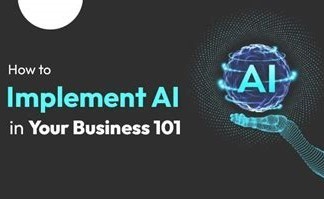
Table of Contents
- Introduction
- 1. Assess Your Business Needs
- 2. Set Clear AI Objectives
- 3. Build Your AI Team
- 4. Choose the Right AI Tools
- 5. Prepare Your Data
- 6. Start with a Pilot Project
- 7. Scale AI Implementation
- 8. Monitor & Optimize AI Systems
- 9. Address Ethics and Compliance
- 10. Train Employees & Foster AI Culture
- Final Thoughts
Introduction
Artificial Intelligence (AI) is no longer just a futuristic concept—it's a business imperative in 2025. From automating repetitive tasks to extracting deep insights from data, AI helps businesses of all sizes innovate and compete more effectively.
Implementing AI successfully requires strategic planning, the right tools, and organizational readiness. This step-by-step guide breaks down the process to help you harness AI’s potential for your business growth.
1. Assess Your Business Needs
Begin by analyzing your current business processes to identify pain points and opportunities where AI can add value. Focus on areas with repetitive tasks, data-rich workflows, customer service challenges, or innovation bottlenecks.
2. Set Clear AI Objectives
Define specific, measurable goals for your AI initiatives. Examples include reducing operational costs, improving customer engagement with chatbots, generating sales forecasts, or enhancing product recommendations.
3. Build Your AI Team
Assemble a cross-functional team comprising data scientists, AI specialists, IT personnel, and business stakeholders. Collaboration across departments ensures AI projects align with overall business strategy and technical feasibility.
4. Choose the Right AI Tools
Evaluate AI platforms and tools based on your objectives. Popular options include OpenAI's GPT models for natural language tasks, DeepSeek for data analysis, and various automation platforms like UiPath or Zapier. Consider ease of integration, scalability, and support.
5. Prepare Your Data
Data is the fuel for AI. Collect, clean, and organize your data to ensure quality input for AI models. Address gaps, inconsistencies, and privacy concerns to maximize accuracy and compliance with regulations.
6. Start with a Pilot Project
Launch a small-scale pilot to test the AI solution in a controlled environment. This allows you to measure impact, identify challenges, and refine processes before wider roll-out.
7. Scale AI Implementation
Based on your pilot's success, develop a roadmap to scale AI integration across relevant functions. Prioritize initiatives with high ROI and strategic importance, and allocate resources accordingly.
8. Monitor & Optimize AI Systems
Continuously track AI performance using KPIs aligned with your business goals. Adapt models and workflows based on results, user feedback, and technological advancements.
9. Address Ethics and Compliance
Implement policies to ensure AI use respects privacy, fairness, and transparency. Stay compliant with local and international regulations like GDPR, and use explainable AI frameworks to build trust.
10. Train Employees & Foster AI Culture
Educate your workforce on AI benefits and functionalities. Encourage adoption by demonstrating AI as a collaborative tool, helping employees upskill and innovate alongside AI.
Final Thoughts
Implementing AI in your business is a journey, not a one-time project. With thoughtful planning, the right resources, and continuous improvement, AI can transform operations, enhance decision-making, and unlock new opportunities.
Start small, learn fast, and scale smartly. Embrace AI as a strategic partner in your business growth in 2025 and beyond.


